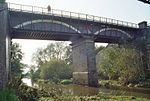Holy Trinity Church, Wolverton
Church of England church buildings in BuckinghamshireGrade II* listed churches in BuckinghamshireHistory of BuckinghamshireUse British English from February 2023

The Church of the Holy Trinity is a Grade II* listed church, incorporating Saxon and medieval elements, located in the town of Wolverton, Buckinghamshire, England. The modern church was rebuilt between 1809 and 1815.
Excerpt from the Wikipedia article Holy Trinity Church, Wolverton (License: CC BY-SA 3.0, Authors, Images).Holy Trinity Church, Wolverton
Old Wolverton Road, Milton Keynes Stratford Park
Geographical coordinates (GPS) Address External links Nearby Places Show on map
Geographical coordinates (GPS)
| Latitude | Longitude |
|---|---|
| N 52.06425 ° | E -0.82977 ° |
Address
Holy Trinity
Old Wolverton Road
MK12 5HN Milton Keynes, Stratford Park
England, United Kingdom
Open on Google Maps









